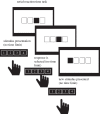The effect of cathodal transcranial direct current stimulation during rapid eye-movement sleep on neutral and emotional memory
- PMID: 30109059
- PMCID: PMC6083708
- DOI: 10.1098/rsos.172353
The effect of cathodal transcranial direct current stimulation during rapid eye-movement sleep on neutral and emotional memory
Abstract
Sleep-dependent memory consolidation has been extensively studied. Neutral declarative memories and serial reaction time task (SRTT) performance can benefit from slow-wave activity, characterized by less than 1 Hz frequency cortical slow oscillations (SO). Emotional memories can benefit from theta activity, characterized by 4-8 Hz frequency cortical oscillations. Applying transcranial direct current stimulation (tDCS) during sleep entrains specific frequencies to alter sleep architecture. When applying cathodal tDCS (CtDCS), neural inhibition or excitation may depend on the waveform at the applied frequency. A double dissociation was predicted, with CtDCS at SO frequency improving neutral declarative memory and SRTT performance, and theta frequency CtDCS inhibiting negative emotional memory. Participants completed three CtDCS conditions (Theta: 5 Hz, SO: 0.75 Hz and control: sham) and completed an SRTT and word recognition task pre- and post-sleep, comprising emotional and neutral words to assess memory. In line with predictions, CtDCS improved neutral declarative memory when applied at SO frequency. When applied at theta frequency, no negative emotional word memory impairment was found but a positive association was found between post-stimulation theta power and emotional word recognition. SRTT performance was also not altered by either CtDCS frequency. Future studies should investigate overnight theta CtDCS and examine the effects of CtDCS during and after stimulation.
Keywords: emotional; memory; procedural; sleep-dependent consolidation; tDCS.
Conflict of interest statement
We have no competing interests.
Figures








Similar articles
-
Oscillating Square Wave Transcranial Direct Current Stimulation (tDCS) Delivered During Slow Wave Sleep Does Not Improve Declarative Memory More Than Sham: A Randomized Sham Controlled Crossover Study.Brain Stimul. 2015 May-Jun;8(3):528-34. doi: 10.1016/j.brs.2015.01.414. Epub 2015 Feb 16. Brain Stimul. 2015. PMID: 25795621 Free PMC article. Clinical Trial.
-
Slow oscillatory transcranial direct current stimulation (so-tDCS) during slow wave sleep has no effects on declarative memory in healthy young subjects.Brain Stimul. 2019 Jul-Aug;12(4):948-958. doi: 10.1016/j.brs.2019.02.012. Epub 2019 Feb 21. Brain Stimul. 2019. PMID: 30842037
-
Transcranial electrical currents to probe EEG brain rhythms and memory consolidation during sleep in humans.PLoS One. 2011 Feb 14;6(2):e16905. doi: 10.1371/journal.pone.0016905. PLoS One. 2011. PMID: 21340034 Free PMC article. Clinical Trial.
-
Promoting Sleep Oscillations and Their Functional Coupling by Transcranial Stimulation Enhances Memory Consolidation in Mild Cognitive Impairment.J Neurosci. 2017 Jul 26;37(30):7111-7124. doi: 10.1523/JNEUROSCI.0260-17.2017. Epub 2017 Jun 21. J Neurosci. 2017. PMID: 28637840 Free PMC article. Review.
-
Can Slow-Wave Sleep Enhancement Improve Memory? A Review of Current Approaches and Cognitive Outcomes.Yale J Biol Med. 2019 Mar 25;92(1):63-80. eCollection 2019 Mar. Yale J Biol Med. 2019. PMID: 30923474 Free PMC article. Review.
Cited by
-
The Impact of Sleep on Fear Extinction.Curr Top Behav Neurosci. 2023;64:133-156. doi: 10.1007/7854_2023_431. Curr Top Behav Neurosci. 2023. PMID: 37495898
-
Commentary: SWS Brain-Wave Music May Improve the Quality of Sleep: An EEG Study.Front Neurosci. 2021 Feb 1;15:609169. doi: 10.3389/fnins.2021.609169. eCollection 2021. Front Neurosci. 2021. PMID: 33597842 Free PMC article. No abstract available.
-
Transcranial Current Stimulation During Sleep Facilitates Insight into Temporal Rules, but does not Consolidate Memories of Individual Sequential Experiences.Sci Rep. 2019 Feb 6;9(1):1516. doi: 10.1038/s41598-018-36107-7. Sci Rep. 2019. PMID: 30728363 Free PMC article.
-
Does Sleep Selectively Strengthen Certain Memories Over Others Based on Emotion and Perceived Future Relevance?Nat Sci Sleep. 2021 Jul 24;13:1257-1306. doi: 10.2147/NSS.S286701. eCollection 2021. Nat Sci Sleep. 2021. PMID: 34335065 Free PMC article. Review.
-
The Role of Emotion Regulation and Awareness in Psychosocial Stress: An EEG-Psychometric Correlational Study.Healthcare (Basel). 2024 Jul 27;12(15):1491. doi: 10.3390/healthcare12151491. Healthcare (Basel). 2024. PMID: 39120194 Free PMC article.
References
LinkOut - more resources
Full Text Sources
Other Literature Sources

